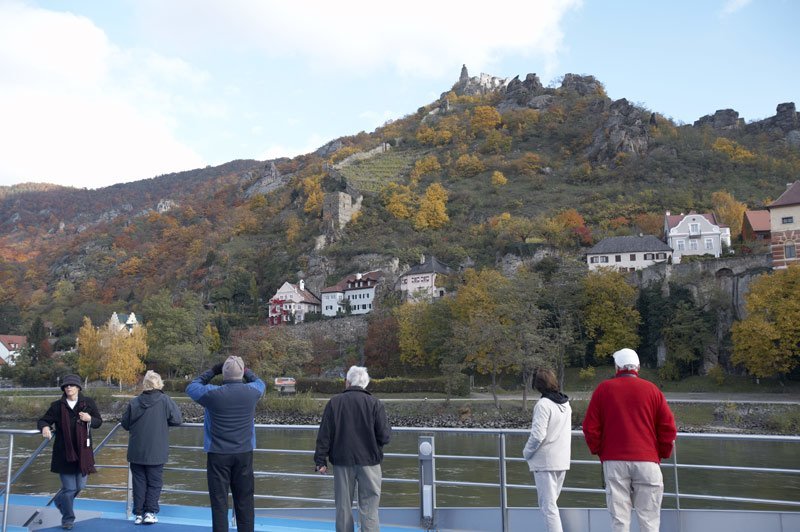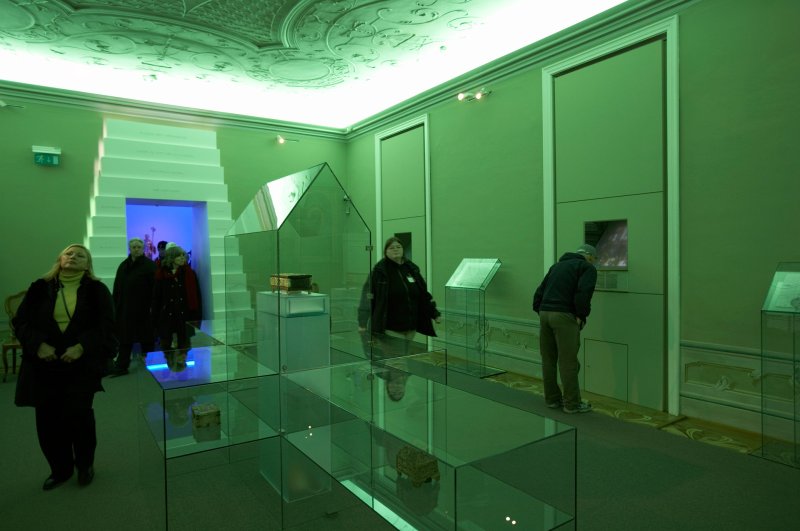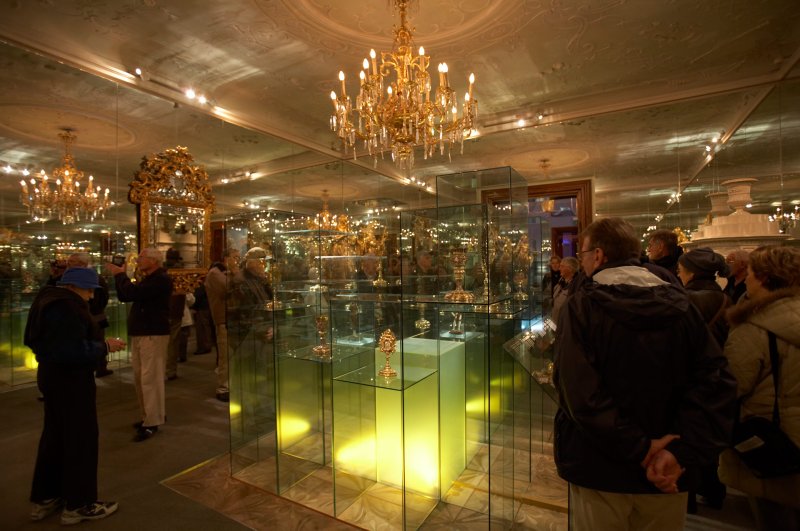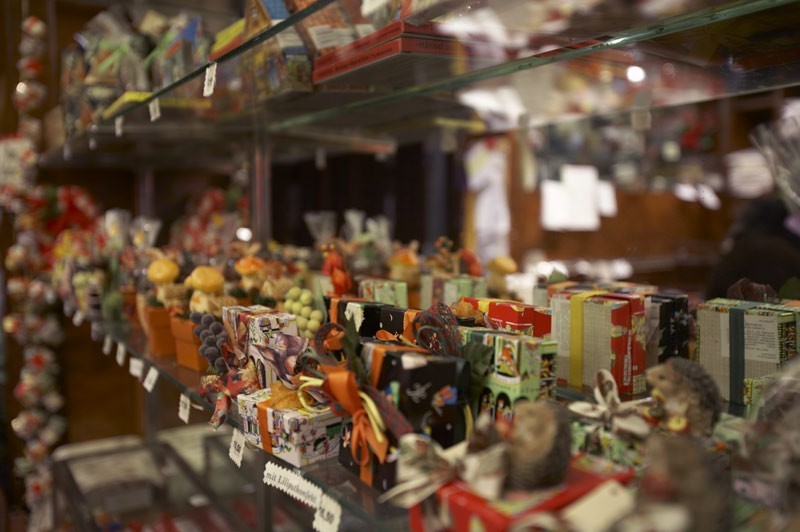A Danube river cruise is a relaxing way to enjoy the charms of Europe. You can leave behind the seasick bags, crumpled maps and long bus journeys. Unpack once and cruise in comfort across Europe while you float along the Danube River from Rousse in Bulgaria, then the Main, Rhine and Moselle rivers all the way to Amsterdam in the Netherlands.
Danube river cruises are a relaxing way to explore charming Danube river cities. Most cruises usually last seven days but stringing two or more cruises back-to-back is fast becoming popular. Cruising is a great way to see many of the famous landmarks in Europe with ease.
While in Europe, also try cruising the fjords of Norway for amazing scenery.
Contents
European River Cruises
European River Cruise Ship


My stateroom is my travelling hotel room for the next two weeks.
It has a French balcony, individually controlled air-conditioning, a queen-sized bed, cosy sitting area, a writing desk and chair.
There are luxurious touches like thick white bathrobes, nice toiletries and bedtime chocolates.
There’s an infotainment system with a monitor, keyboard with internet access, English language TV stations and a selection of movies and music.
The ship’s indoor and outdoor common areas include a sun deck with 360° views, main and rear lounges, fitness centre, beauty salon, library, 24-hour front desk, onboard shop and restaurant.
A European river cruise is definitely one of the most comfortable ways to see difficult-to-reach destinations, especially so in Eastern Europe.
River ships are far more luxurious than many hotels available in some of the destinations you’ll visit.
Here’s a river cruise packing list of items you will need to bring along.
Cruising is a fun way to travel with friends (read these friends quotes for inspiration) and share these travel quotes with your best friends.
Danube River Cruise and Rhine River Cruise Itinerary
Black Sea (Rousse to Budapest)

I begin my trip in Istanbul where Byzantine and Ottoman history have left a legacy of dreamy mosques and beautiful churches.
There are grand palaces and vibrant souks.
There are so many famous Turkish landmarks in Istanbul: the marbled courtyards of the Topkapi Palace, the majestic Blue Mosque, ancient Roman Hippodrome and Aya Sofya (which has been a cathedral, a mosque and a museum).
Istanbul’s Grand Bazaar is a warren of shops and selling all kinds of things from Turkish delight to handmade soaps and Turkish carpets.
Keep an eye out for those insistent carpet salesman and don’t believe anything they tell you unless, of course, you’re keen on shipping home an overpriced carpet.
From Istanbul, we travel by bus to Bulgaria where there’s an overnight stay in Nessebur, a Bulgarian seaside town by the Black Sea, and a walk around historic Veliko Turnavo before arriving at the MS Amalegro in Rousse.
We cruise to the Hungarian port of Mohacs and bus through the countryside to Pecs.
Here the mood is upbeat with dances, concerts and plays organised for the 2010 European Culture Capital celebrations.
Bucharest (Romania)
The ship docks in Giurgiu for our first excursion where we travel to Bucharest, Romania’s capital, by bus.
Each day brings us to a new town or city.
From wandering through the shops in Novi Sad in Serbia to watching a play in Vidin’s ancient fort in Bulgaria, each excursion is unique.
Vukovar (Croatia)
Vukovar in Croatia was completely devastated in the 1991 Battle of Vukovar. Here our guides have captivating personal tales of wartime experiences.

One highlight is cruising through the Iron Gates, where the Danube flows through narrows gorges as the river winds between the Carpathian Mountains and the Balkan Mountains, with Serbia on one bank and Romania on the other.

Budapest to Nuremberg

It’s easy to see why Budapest is a favourite city to start or end a European river cruise.
The historic World Heritage castle precinct on the hilly Buda bank offers a picture-postcard view of the Pest side with its graceful Neo-Classical and Art Nouveau architecture.
From tasting cakes to taking a dip at a historic thermal bath, there’s plenty to see and do.
From Budapest, the ship meanders along the river through four countries – Hungary, Slovak Republic, Austria and Germany (you might also like to brush up on these fun facts about Germany).
Nuremberg has a number of famous German landmarks from World War II and earlier.


Wachau Valley (Austria)
Austria offers some of Europe’s most stunning scenery.
Autumn is a magical time to cruise through Austria’s Wachau Valley past forests of spun gold and burnt ochre.
The countryside is bursting with Baroque abbeys, medieval fortresses, vineyards, villages, bike trails and country lanes.
Melk Abbey (Austria)
By the time the ship docks at Melk, many of the guests have taken up the mantra: “oh no, not another bloody church” and even though the Abbey is one of the most famous landmarks in Austria, quite a few passengers decide to stay on board.

If you’ve seen Umberto Eco’s monastery mystery Name of the Rose, you might think that Melk Abbey, where the author researched his book, is filled with damp dungeons and dusty books.
The first inkling I’m on the wrong track is the impressionistic contemporary art frescoes painted on the outside walls of one of the courtyards.
It’s not quite what you’d expect at a Benedictine monastery that has been home to monks for over 900 years.

I follow the museum guide into the Emperor’s Gallery, where the cream of European society who visited the abbey throughout the centuries was once accommodated.
These days, the former VIP rooms are now occupied by the Abbey Museum, a 21st-century showcase of Benedictine grandeur.

The museum is a treasure trove of ancient relics displayed behind modern glass cases.
Rooms are bathed in soft luminescent lighting; the first room is blue, the next lime green, then gold and so on.



The Austrian word “hore” (listen) is projected on some walls.
Video presentations and laser projections of ancient words give the museum a kind of space-age ambience. Mirrors are used everywhere for effect.
The result is a combination of technology and old European grandeur.
I feel like I’m walking through the set of a Star Wars sequel.

The museum’s story starts with Saint Benedict who founded the Benedictine order.
Melk Abbey was built as a castle for Austria’s Babenberg rulers.
In 1089, Leopold II gave the castle to Benedictine monks and throughout history, the Babenbergs donated relics and works of art to the monastery.

Interesting items on display include a 16th-century steel strongbox with twenty locks that snap shut at the turn of a tiny key and a medieval painting of Christ’s Passion depicting Pontius Pilate in the turban of a Turk.
The Marble Hall is a marvel of ornate imperial baroque style.
The 18th-century ceiling fresco by Paul Troger shows Greek goddess Pallas Athena on a chariot drawn by lions.

Between the Marble Hall and the Great Library is an open-air terrace with a view of the town and the Danube River.
The library was once one of the greatest in medieval Christendom and is housed in a baroque building of similar decor to the Marble Hall.
Around 100,000 manuscripts, incunabula (printed works before 1500) and books fill the floor-to-ceiling bookcases.

There are carved wooden reading tables in the centre of the library, bay windows and display cases for some of the library’s most treasured items.
The next stop is the abbey church, which is a spectacular baroque affair with twin onion-domed towers, a high cupola and gold pulpit.
Mass is conducted on Sundays and there are midday prayers here each day.

Melk Abbey is a gem that survived the days of Emperor Joseph II, the Holy Roman Emperor who closed down many other Austrian abbeys during his rule.
It survived the Napoleonic Wars and the Nazi Anschluss where Austria became part of Nazi Germany in 1938.
To those who stayed on board, all I can say is Melk Abbey is definitely a gem worth visiting.

Regensburg (Germany)


Durnstein (Germany)
A highlight of this European river cruise is tasting schnapps in Durnstein while contemplating the fate of Richard the Lion Heart, who was a prisoner there in 1193.
Another memorable moment is munching on sausages and drinking beer at Germany’s oldest sausage kitchen in Regensburg.
Main Danube Canal

A highlight of the cruise is the ride along the Main Danube Canal. Completed in 1992, the 171-km canal links the Rhine River, via its tributary the Main River, with the Danube River.
This linking of the two rivers allows ships to sail from the Rhine delta, at Rotterdam in the Netherlands, to the Danube delta in eastern Romania.
It connects the North Sea to the Black Sea.
The canal enables ships to sail from the Rhine delta (in the Netherlands) to the Danube Delta (in Romania), from the North Sea to the Black Sea.
The canal climbs 176 m from the city of Bamberg to the top of the European divide at 406m.
From there it descends to the village of Kelheim before connecting to the Danube.
Ships traverse the canal through a series of 16 locks.
Travelling through the locks where the water levels rise or fall is an experience in itself.
At the flick of a switch, the ship’s bridge automatically lowers so the vessel can pass beneath the overhead bridges.
At the highest point, which is marked by an unimpressive concrete wall, our captain gathers the passengers in the main lounge and we toast our arrival at the top of the canal.

Nuremberg (Germany)


World War II history is the theme in Nuremberg.
Hitler chose Nuremberg as the site for his annual Nazi party rallies and the city later became the location for the Nuremberg Trials where Nazi party leaders were held accountable for WWII war crimes.
One of the benefits of river cruising is the intimate boats offer the chance to make and bond with many new friends.
Although my European river cruise ends in Nuremberg, my new friends continue cruising through Germany to marvel at fairytale castles, medieval UNESCO World Heritage Bamberg (famous for its smoky-tasting rauchbier), Wurzburg’s regal splendour, wonderful glassworks in Wertheim and Cologne famous cathedral.
Amsterdam (Netherlands)
Amsterdam is another main cruising destination.
It’s easy to fall in love with tranquil canals that ring the centre, curvaceous bridges, rows of gabled buildings and its snug cafés and bars.
As you can see, cruising is a comfortable and luxurious way to tick many places off your European bucket list without the hassle of packing and unpacking.
European Christmas Markets Cruises
Experience the wonder of a white Christmas on a cruise along the Rhine and Main Rivers.
The scenery is some of Europe’s most picturesque, an enchanting postcard of snow-covered wintery landscapes and sparkling Christmas lights. And the European Christmas markets are truly enchanting.

Delicious aromas of roasted almonds and chestnuts, gingerbread and smoked sausages waft through the air. The atmosphere is rich with carolling and yuletide cheer.

A Christmas-time cruise through the land where many Christmas traditions began is something cruise-lovers should try at least once, even if you’ve already been on a European river cruise at a different time of the year.
Cruising is an opportunity to lap up Europe’s Christmas atmosphere while exploring places where tree ornaments, Christmas toys, gingerbread men, nutcrackers and Saint Nicholas folklore were invented.

Germany’s Christmas Markets

In every city and town, there are shops that sell unique hand-made Christmas gifts like pottery or whimsical metal sculptures.
And specialist Christmas shops with a fantastic choice of high-quality hand-made Christmas decorations.
You’ll find delightful carousels and music boxes decorated with reindeer, miniature Santas and figures from biblical times.
One of the highlights of the cruise is the visits to Germany’s oldest and most famous Christmas markets in Nuremberg, Rothenburg and Frankfurt.


There’s no better way to end a walking tour of Nuremberg’s historic centre, which is encircled by mighty defensive walls and guarded by an imposing castle than to indulge in tasty treats of gingerbread, sausages, and sweet-and-spicy hot-mulled wine at the city’s Christkindlesmrkt.
Located in the medieval city’s main square, this market is also famous for toys and angels; the first angel was sold here over 400 years ago by a local doll maker.

The UNESCO World Heritage city of Bamberg offers the opportunity to admire elaborate nativity scenes displayed in its churches, museums and squares.
The Bavarian fairytale city is also the Franconian centre for beer where the smoky flavoured Rauchbier is a local specialty.
An excursion along Germany’s picturesque Romantic Road through dreamy vistas of fairytale Bavarian castles, rolling hills, lakes and medieval towns ends in Rothenburg.
Wandering through Rothenburg’s Christmas market located among gothic churches and medieval gabled houses is a magical experience.
And the Christmas season here offers an extra special vibe with events like puppet shows and outdoor concerts.
The Christmas delights continue at Wertheim, where for centuries glassblowers have produced Christmas tree ornaments, and Frankfurt, which is a festive fairyland of glittering stalls dwarfed by a giant Christmas tree.
Frankfurt is also home to some of Germany’s best museums.
Cologne’s six Christmas markets, including the Cologne Cathedral Market, are sure to impress.
The cathedral itself is a must-see, a grand masterpiece of Gothic art that took over 600 years to build.
A Christmas cruise is especially festive, with Christmas decorations and a celebratory atmosphere. It’s a Christmas present worth considering for this year’s stocking.


Plan Your Trip

Rent A Car – Find the best car rental rates at Discover Cars. They compare car hire companies to provide you with the best deal right now.

Find A Hotel – If you’re curious about this article and are looking for somewhere to stay, take a look at these amazing hotels.
